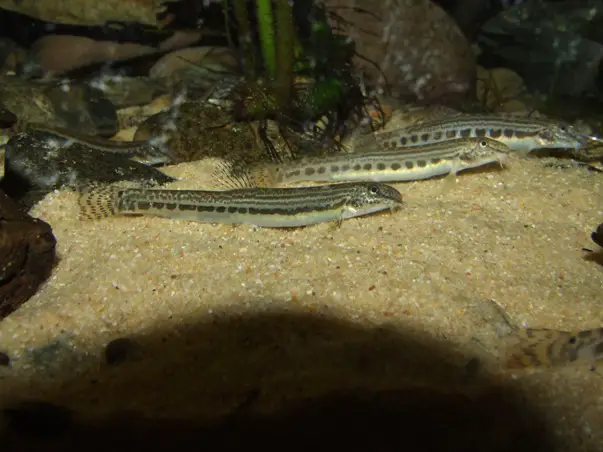
C. sp. 1 was initially imported as Misgurnus anguillicaudatus © Thomas Frank
Thomas Frank introduces three recent additions to the aquarium hobby…
For loach-lovers 2008 was certainly not the worst year. It started in the middle of the year, when small loaches arrived in Aachen under the name Misgurnus anguillicaudatus but which could easily be identified as members of the genus Cobitis.
They came from the Dutch ornamental fish wholesaler Ruinemans and I was unable to establish the precise identity and origin of the fish so designated them Cobitis sp. 1.
Only later I stumbled upon the website http://blog.xuite.net/snakejoan/snake/28724172 where some undefined Taiwanese Cobitis are depicted which appeared very similar to mine. From Matt Ford I received an additional pointer that some loaches very similar to mine are included in Chen and Chang (2005), this time with the name Cobitis cf. sinensis.
The origin of these loaches should thus almost certainly be Taiwan and this was confirmed in Spring 2009 when Aqua-Global of Seefeld imported some specimens originating from Taiwan under the name Cobitis sinensis.
Some of these animals arrived to the company Schwabenaquaristik in Aulendorf, who thankfully granted my request for a photograph of them very quickly. These loaches also seemed identical to mine, so I assumed that the fish from all of these different sources were the same species.
The males have a rounded lamina circularis (as far as I can tell) and the typical extended second pectoral spine, and the sexes in cobitids can typically be told apart in this pretty clear and simple way. It is a rather small loach with the largest female around 8 centimeters and the biggest male not much more than 6 centimetres in total length.

C. sp. 2 has been traded as Cobitis chinensis in the past © Thomas Frank
The fish have already bred in my aquarium and I will provide details about this in a later report.
At the end of the year the ornamental fish wholesaler Mimbon Aquarium in Cologne joined the ‘loach spotlight’ in which two Cobitis species were imported for the retail sector at the same time (one of them in smaller numbers as bycatch).
This time China was clearly stated as the origin from the time of import and later Hans-Georg Evers (2009) specified them to be collected in Guangdong Province.
The animals were traded as ‘chinensis’ but unfortunately this name has never officially been used within the genus Cobitis, not even as a synonym, and they may even represent an undescribed species (here they are referred to as Cobitis sp. 2).
The fish have an unusual colour pattern which differs quite clearly from other Cobitis spp., so different in fact that at first I thought it may eventually prove not to be a member of Cobitis and perhaps be assigned to the genus Iksookimia.
The pattern of spots arranged along the sides of the body is highly variable and ranges from almost symmetrical rectangles to narrow, vertical stripes or ‘drops’.
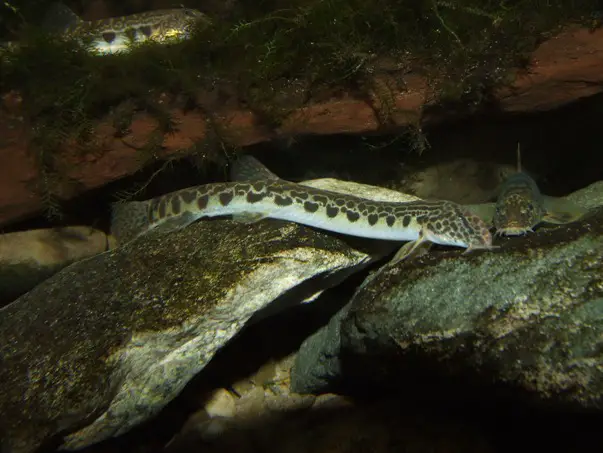
Female of C. sp. 3 © Thomas Frank
Here too the males have a rounded lamina circularis and due to the size of the fish it is easy to see that the second pectoral-fin ray is extended and bent slightly upwards.
I was not pleased with the sex ratio of my new loaches, though, because among the group of 18 animals I could see only 2 males and, accordingly, 16 females.
I was able to add two more males to my already more-than-sufficiently large group from Aqua-Tropica in Cologne, and I also took the last remaining females from there.
The most striking character about these fish was their size which was quite impressive for a loach. At time of purchase all of them measured at least 10 centimetres with the largest thirteen centimetres TL. The height of the body is around 15 millimetres. After around 2½ years of maintenance I could no longer detect any growth.
A second species from Mimbon (Cobitis sp. 3) was as already mentioned imported as byctach alongside the ‘chinensis’ fish. They are considerably less deep in the body than the ‘chinensis’ but have a similar length and a typical pattern of spots on the flanks.
In comparison with other Cobitis species the dorsal-fin is placed quite far back on the body, though not to the extent as seen in weather (Misgurnus) or kuhlii (Pangio) loaches. I originally managed to pick up just three of these ‘cobitid bycatch’, all females, but on my aforementioned visit to Aqua-Tropica I was fortunate to find a male and additional female.

Male of C. sp. 3 © Thomas Frank
I have not yet been able to observe a lamina circularis in the male, but at present I am unable to say whether it really doesn’t exist or I am yet to discover it.
The maintenance of these loaches is unproblematic and care only needs to be taken when keeping them alongside other fishes. Cobitids tend to eat slowly and the two large examples presented here are no exception, so any tankmates must be chosen with this in mind.
Moreover, one must not give a lot of thought if wishing to keep these fish in an aquarium. A heater is not always required although higher temperatures are tolerated well.
Two practical examples: I maintained a group of the fish first-exported as ‘C. chinensis’ for two years in a cement tub in temperatures of around 15 °C on average. The temperature only rose above 20 °C on some warm days, and the fish spent winter in the basement at around 5 °C. The other group lives in an aquarium at room temperature.
With prolonged summer heat the aquarium temperature may rise to approximately 30 °C but I there were no losses in either group and all now live together in an aquarium.
A soft, sandy substrate, within which the fish will bury themselves at times, plus several flat stones arranged to form hiding places and some submerged roots complete the set-up. Even plants are not damaged or uprooted by the fish as they forage.

C. sp. 1 is probably collected in Taiwan © Thomas Frank
That said, I tend to keep nothing except cryptocorynes in my loach tanks since with larger stem plants there could be problems, especially in combination with larger and stronger cobitids.
Regarding food the only consideration is that it must sink to the bottom with live black mosquito larvae ideal for cobitids, although they also accept frozen varieties with enthusiasm.
White mosquito larvae are less useful for these fish since they live more in open water plus the defrosted remains tend to float on the surface. Both live and frozen bloodworm or Tubifex are very suitable foods, though.
I feed only live Tubifex because some of them bury into the sand and serve as a more constant source of food for the loaches. Often the loaches are still feeding on the Tubifex the following day, some of which have become deeply buried in the sand, so the fish must perform a ‘headstand’ to find them!
Sinking dried tablets and granules designed for benthic fishes and of a suitable size for their mouths are also happily taken by my Cobitis.
All in all these are easy loaches to keep but as with many other loach genera they do not have a large fan-base.
Literature
Evers, H.-G. (2009): Schmerlen aus China. Amazonas, 5 (3): 72-73
Chang, I.-S. & Chen, Y.-C. (2005): A Photographic Guide to the Inland-Water Fishes of Taiwan: Volume 1: Cypriniformes 254-259
NB: this is a translation of the article “Drei neue Steinbeißer der Gattung Cobitis” which was originally published in the BSSW-Report 3/12.

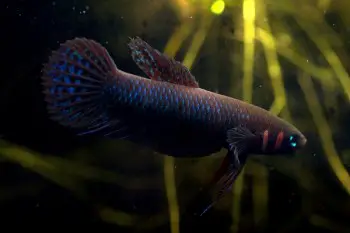

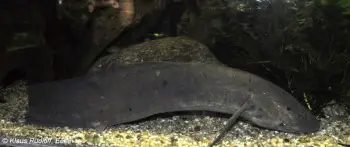





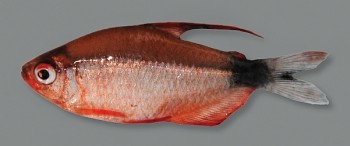





Product reviewers wanted
Are you still looking for product reviewers?
19th Dec 2024
Product reviewers wanted
Hey! Interesting article!
17th Dec 2024
Site improvements
Got it! Thanks for the update. It's good to know that Seriously Fish is working on improving the site's performance and addressing the email and forum...
21st Nov 2024
Responsive design
Nice
13th Nov 2024
Responsive design
it is a complete malfunctioning horror on iphone and ipad.
10th Nov 2024